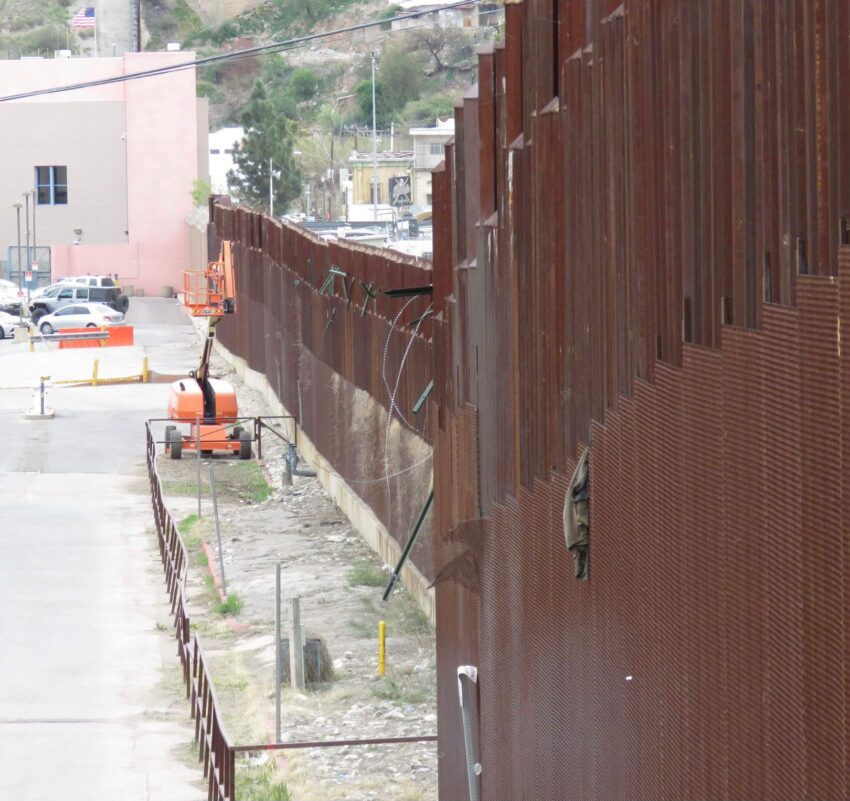I had to do a double take. The razor wire, which had draped down over the border wall in Nogales, Arizona, for five years, was suddenly gone. I was just west of the DeConcini port of entry. This part of the border wall slopes up a hill, the same hill where Border Patrol shot into Mexico and killed 16-year-old José Antonio Elena Rodríguez in October 2012. At the top of the hill, a mounted camera monitored the border wall. What, I wondered, is going on? Where’s the concertina wire?
And is this a good thing?
A resident out in front of her house, doing yardwork, seemed to think so. Her house was one of several that faces the border wall, where it cleaves Ambos Nogales in two. She said they were indeed taking down the razor wire. “Se ve más bonito,” she said (It looks nicer). Then she paused and added, “Well, it’s hard to say más bonito.” It was, after all, still a border wall, but prettier without the razor wire. The aesthetics had improved.
But was this really an improvement?
In 2019, when I first stumbled upon the U.S. military installing the coiling concertina wire, I was just as startled. This was the Trump administration’s contribution to the Nogales border wall, which had taken various forms since 1995 after the long-standing chain-link fence was plucked out of the ground.
The first iteration in 1995 was a 15-foot wall made of Vietnam and Gulf War landing mats as part of Operation Safeguard, the Arizona deterrence operation that came on the heels of Operation Gatekeeper and Operation Hold the Line. The next makeover happened more than a decade later, when, as part of the Secure Fence Act, excavators and bulldozers pulled out the landing mat wall as if they were doing dental work. This was 2011 and they were putting up an 18 foot bollard wall. They did this in small sections, revealing little wall-less swaths of border, a brief reminder of what once was and what could be.
The resident’s house was at the point where the removal operation ended. The razor wire started up again on the wall in front of her house and looked disheveled—its barbs had clawed bits and pieces of clothing and weeds, and one coil had captured a stuffed animal.
Why hadn’t they removed this part? I wondered.
I walked up to the top of the hill to ask the Border Patrol agent stationed under the mounted cameras what was happening, and he told me that he went on vacation, and when he came back, the wire was gone. “I honestly don’t know,” he told me. “I don’t know if they are going to put it back. It’s over my head.”
In late March, however, journalist Daniel Torres of the Nogales newspaper Nuevo Dia reported that a CBP spokesperson told him that “advances in technology, specifically to detain people who cross over the top of the wall illegally, have allowed the agency to stop these types of measures, now that they have much more effective systems for these activities.” By measures, they meant concertina wire. And by more effective systems, they meant some sort of technology. When I asked Torres if he knew what technology specifically, he said the spokesperson wouldn’t say. I thought of the wall I saw on the Palestinian West Bank with black cables—a sensor system—weaving through steel bars. If you touched, cut, or climbed this barrier, or even came near it wearing or carrying any metal, the fence would give “a precise indication of what is going on there,” Israeli colonel Danny Tirza explained. This was an example of a so-called smart wall.
I had no idea what they were planning in Nogales, nor if it would be anything like this. But was this a technology-for-razor-wire swap?
After all, in Nogales, the razor wire has been unpopular with city officials since the get-go. In 2019, Nogales mayor Arturo Garino said, “I don’t know why [Nogales is] being used as their concertina poster city. This is not right.” In a 2019 resolution the City Council called the wire “lethal” and “in the immediate proximity of our residents, children, pets, law enforcement and first responders.” When the presidential administrations changed hands in 2021, Garino tried again, but with caution: “I know that the government has a tendency of, when they put something up, they always keep it up, doesn’t matter what administration is there. But let’s see how this administration is. And I said, if anything, remove the wire that’s all the way down to the ground.”
But nothing had been removed—not on the bottom, not on the top—until now. When I brought this up with the current mayor, Jorge Maldonado, he told me, “The wire is being moved in order to do some repairs and maintenance on the wall.” And they were going to reinstall. This was the first time I got the inside information that the razor wire wasn’t going anywhere, but I had to confirm with CBP, which started a multiday game of phone tag. When I asked Maldonado his position, he said, “All I can say on this is that it doesn’t look good, and what the federal agencies do will be accepted by us.”
Later, I asked another agent stationed by the border wall, and he made sure I knew that “I’m not in the know, and I’m not sure.” And then he said, “I’m not sure if they’re removing it permanently or not, but it looks like they are putting more things up and doing maintenance.”
When I finally connected with a CBP spokesperson, I realized “maintenance” was the key word. He confirmed that the plan was to “reinstall” the concertina wire after the maintenance was done. When I asked if other portions of the wire would be removed for maintenance, he told me he couldn’t reveal too much. When I asked if this was a border-wide initiative, he told me he could only speak to Arizona. And he couldn’t comment on the technology question, just that certain “capabilities” might be added in certain areas.
What I gather from all this is that the wall is indeed becoming “smarter.” At the very least—as when the landing mats were added in 1995, the bollards in 2011, and the razor wire in 2019—the wall is in another metamorphosis. It seems that instead of being removed, the coiling razor wire will go hand in hand with any high-tech upgrades.
Read more: Read More




